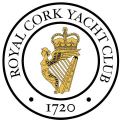

ROYAL CORK YACHT CLUB
1720
Royal Cork Yacht clubKnocknagore, Crosshaven, Co. Cork, Ireland..
Eircode: P43 HD40
Phone N° +353.21.483.1023
⇒See location on Open Street Maps CLICK HERE
The Royal Cork Yacht Club is one of the World's leading Yacht Clubs and is to the forefront of all branches of sailing activities. The RCYC is the organiser of the biennial Cork Week Regatta, regarded as Europe's premier sailing event. The RCYC has hosted many National, European and World championships. Its members compete at the highest level in all branches of sailing, and the club membership includes a number of World, Olympic, European and National sailors.
EARLY HISTORY OF SAILING
EARLY 1600'sThe idea of sailing for pleasure became popular in the Netherlands in the early 1600's. Later in that century during the Cromwellian years in Britain, the English King Charles II was in exile in the Netherlands and he became interested in this new and exciting pastime. In 1660 when King Charles II was restored to the English crown and returning from exile his Dutch friends presented him with a yacht called Mary which he sailed enthusiastically on the River Thames in London. Soon several of his courtiers followed his example. Ireland was partially occupied by the British, after the failour of the siege of Kinsale 1601 and the defeat of the Irish and Spanish armies in 1602, the king's courtiers Murrough O'Brien, the 6th Lord Inchiquin, upon returning to Cork introduced the pass-time and private sailing became popular in Cork Harbour.
1720
By 1720 interest in the sport of sailing had increased so much that his great grandson, the 26 year old William O'Brien, the 9th Lord Inchiquin together with five of his friends established the Water Club of the Harbour of Cork, known today as the Royal Cork Yacht Club, the oldest yacht club in the world. They formed the club in a castle on Inis Sionnach / Haulbowline Island in Cork Harbour. They regulated their sailing, their membership and their dining affairs according to rules known today as The Old Rules. These rules included the title of Admiral, membership being limited to 25 and club visitors were reqired to overnight at the captain's home. A yacht race was known as the chase.
In the early years the majority of club sailing activities took the form of sailing in various formations, copying the manoeuvres of the navies of that time. They communicated with each other by flying different flags and by firing cannons. Each display and sequence of flags or cannons meant something and every yacht owner carried a common signal book on board to facilitate this method of communications.
1806
Shortly before 1806 the club had to relocate to Cove (Cobh) as the British Admiralty decided they required the whole island of Haulbowline for the British navy. The American Revolution 1775 to 1783 and the French Revolution of 1789 were significant factors in the British Navy's decision to fortify their presence in the safe and strategic Cork Harbour. Kinsale had been the main location for the British navy (the reason for the Spanish Armada landing in Kinsale in 1601). By the eighteen hundreds Kinsale harbour had begun to silt badly causing difficulties for the British warships which had become bigger with deeper draughts. Hence their move to Haulbowline in Cork Harbour. By this time the sailing club began to call itself the Cork Harbour Water Club
1820's
During the 1820's the Cork Harbour Water club changed its name again to include the word Yacht and dropped the Water, it became known as The Cork Harbour Yacht Club. Later in that decade it dropped the word Harbour and became known as the Cork Yacht Club.
1831 & 1854
In 1831 the English King, William IV, granted the club the privilege of using the prefix Royal and the club become known as the Royal Cork Yacht Club. The club had moved to various premises in the town of Cove (Cobh) and in 1854 it moved into a magnificent new building built on land given to it by the British admiral J.H Smith Barry of Foaty House (Fota House). Club membership was keenly sought after and club records show that many candidates were disappointed.
One who was fortunate to be admitted was Prince Ferdinand Maximilian of Austria, later to be Emperor of Mexico. Prince Ferdinand was the brother of Emperor Franz Joseph, the founder of the Imperial Austrian Navy. On the 30th of November 1858 at a special meeting of the General Committee of the Royal Cork Yacht Club it was felt that the proposal to allow (foreigners) Prince Ferdinand's name to go forward for ballot for membership might cause the British Admiralty some concern, however he was duly elected to membership.
The 1900's
One of the very first sailing heroes, Sir Thomas Lipton, who challenged for the Americas Cup sailing a series of yachts called Shamrock, was admitted to membership of the Royal Cork Yacht Club in 1900. The first Fastnet Race in 1925 had a fleet of seven, the 30 year old yacht, the Gull, a Cork boat after racing for over 7 days came second. The Gull was sailed by a solicitor and a member of the Royal Cork Yacht Club, H.P.F. Donegan. It was during this first Fastnet Race that the owner of the boat that won the race, the Julie Brise, George Martin formed the Ocean Racing Club, now known as the Royal Ocean Racing Club.
1966
The Royal Munster Yacht Club and the Royal Cork Yacht Club merged in 1966 and moved from Cobh to its present location in Crosshaven.
The Royal Cork Yacht Club website is HERE
Become a Member of the Royal Cork Yacht Club - Details HERE
Cork Week website is HERE
Back to Top
Published July 2024 / Foilsithe Iúil 2024
Become a Member of the Royal Cork Yacht Club - Details HERE
Cork Week website is HERE
Back to Top
Published July 2024 / Foilsithe Iúil 2024
Copyright crosshaven.net 2024©
All Rights Reserved
All Rights Reserved
 crosshaven.net
crosshaven.net